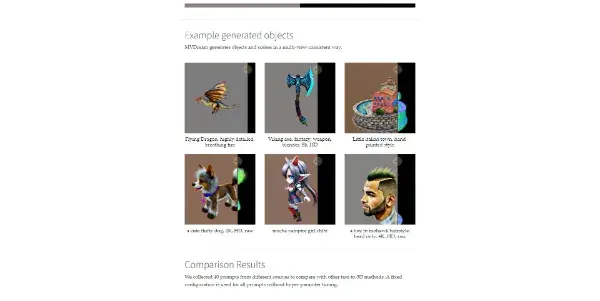MVDream

Generate 3D models from text (prompt). Benefit from 2D diffusion and 3D data consistency
MVDream: Generating 3D Models from Text Prompts
MVDream is a groundbreaking open-source project available on GitHub that leverages the power of AI to generate three-dimensional (3D) models directly from text descriptions. This innovative tool utilizes a combination of 2D diffusion models and 3D data consistency techniques to produce relatively high-quality 3D outputs, significantly streamlining the 3D modeling process.
What MVDream Does
At its core, MVDream translates natural language prompts into detailed 3D models. Users input a text description specifying the desired object, its features, and style, and the AI generates a corresponding 3D representation. This process eliminates the need for manual 3D modeling, offering a faster and potentially more accessible route to creating 3D assets.
Main Features and Benefits
- Text-to-3D Generation: The primary feature is its ability to convert textual descriptions into 3D models. This allows users without 3D modeling expertise to create complex shapes and objects.
- Combination of 2D Diffusion and 3D Consistency: MVDream's unique approach blends the strengths of 2D diffusion models (known for their image generation capabilities) with 3D consistency checks, resulting in improved model quality and coherence. This hybrid approach mitigates common issues found in purely text-to-3D methods, such as inconsistent geometry or inaccurate representations.
- Open-Source and Free: Being an open-source project hosted on GitHub, MVDream is freely accessible to anyone, fostering community collaboration and development. This lowers the barrier to entry for both users and developers.
- Potential for Customization: As an open-source tool, MVDream allows for modifications and adaptations to suit specific needs and workflows. Advanced users can potentially fine-tune the model for specialized applications.
Use Cases and Applications
The potential applications of MVDream are vast and span various industries:
- Game Development: Rapid prototyping of game assets, creating unique environments, and generating character models.
- Architectural Visualization: Quickly generating 3D models of buildings and structures from textual descriptions for preliminary design reviews.
- Product Design: Facilitating the initial design phase by allowing designers to explore various concepts based on textual descriptions.
- Film and Animation: Creating quick 3D models for scenes, characters, or props.
- Education and Training: Providing an accessible and interactive way to learn about 3D modeling concepts.
Comparison to Similar Tools
Several other tools offer text-to-3D generation capabilities, but MVDream distinguishes itself through its open-source nature and its unique combination of 2D diffusion and 3D consistency techniques. While commercial solutions might offer more polished outputs or advanced features, MVDream provides a compelling alternative for users seeking a free and customizable option. Direct comparisons require benchmarks against specific tools like DreamFusion or Point-E, focusing on output quality, generation speed, and resource requirements. Further research would be needed to definitively state its superiority or inferiority in specific metrics.
Pricing Information
MVDream is completely free to use. As an open-source project, there are no licensing fees or subscription costs associated with its use. However, users are responsible for the computational resources needed to run the software.
Conclusion
MVDream represents a significant advancement in text-to-3D generation technology. Its open-source nature, combined with its innovative approach to model creation, makes it a valuable tool for both professionals and enthusiasts seeking to leverage AI for 3D modeling tasks. While further development and refinement are likely, its current capabilities offer a compelling glimpse into the future of accessible and efficient 3D content creation.